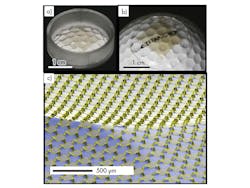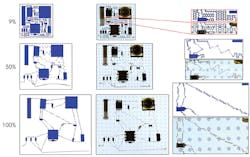Download this article as a .PDF
The future has arrived in the form of medical wearable devices. These devices are often comprised of a ridged box of electronics with a battery and some type of adhesive, so that it can attach to the patient’s skin. This close contact can be a problem when you consider that some wearables stay on for long periods of time. Comfort is incredibly important, as anyone who wears a prosthesis could tell you. And trying to mount a stiff silicon chip and hard-bodied battery on a ductile human body, isn’t necessarily comfortable.
So how can we offer PCBs, chips, sensors, and a power source in a comfortable package? Dr.Yonggang Huang, professor of mechanical engineering, civil and environmental engineering, and materials science and engineering at Northwestern University, thinks the answer is to make the electronics as “squishy” as a person.
One test of an electronic devices ability fo conform to a shape is by using a golf ball. "The golf ball has a lot of dimples and is more complex than most body shapes. If we can place flexible/stretchable electronics on a golf ball successfully, then we should have no difficulties to comformally place it on any part of the body," says Dr Huang. "But the key is not to get the electronic in the form of the golf ball, but to make it like a Band-Aid that will take the natural shape and stretch with whatever it is put on.”
The challenge with this is that the human body takes on many shapes. Band-Aids alone come in multiple shapes. Also, manufacturing processes tend to lean toward simple 2D structures. Knowing what will happen to the shape and how it might affect the circuit once it’s on the 3D body is important. Fortunately, we already have a lot of knowledge and defined properties for materials that we know are safe for the human body. This data can be designed in software and simulated.
FEA and Simulation
Using programs such as SIMULA from Dassault Systems, Huang has already generated many shapes that have been manufactured and match the simulation. Some companies are already using wearable or flexible electronics technology to develop commercial products are:
- Reebok’s CHECKLIGHT—headgear that measures impact to the head.
- L’Oreal’s UV patch—a sticker that lets you know how much UV damage your skin has received .
- MC10 - WiSP—a wireless self-adhesive pad for health monitoring Glucose from sweat.
FEA and simulation software are (and have been) accelerating time to market and reducing cost. Testing designs in software helps with time between iterations, as well as predicting how the geometry will change and stretch when applied to a dynamic 3D surface. "Professor John Rogers from Northwestern University is a key player in this development," says Dr Huang. "He focuses on the design, modeling, simulation, optimization, and his is responsible for the design, fabrication, system integration, and applications of this technology."
"The human body shape is curvilinear, but the conventional electronics are flat," says Dr Huang. "There is clearly an incompatibility here, i.e., the conventional electronics, being rigid, cannot be wrapped conformally on the complex shapes such as heart or brain. One example is a Band-Aid which can be wrapped onto the finger without much difficulty, but if it is wrapped onto a finger tip, then the Band-Aid will have a lot of wrinkles and folds. The conventional electronics cannot be wrapped onto such complex shape, but stretchable electronics can since, at the place of wrinkles, the stretchable electronics can stretch itself like a rubber band."
The Difference Between Flexible and Stretchable
The ability to 3D print electronics has led to a lot of talk about flexible electronics that use conductive inks on a flexible substrate. However, stretching that substrate adds a new level of complexity. Wires and inks might be able to form and flex without a problem, but they can’t be stretched. Once that challenge is solved, you still have the hard, brittle silicone chip that must be designed in a way so that it doesn’t break. 3D printing can deal with polymers and some metals, but not inorganic semiconductors like Silicon. Therefore 3D printing cannot be used to fabricate electronics (involving lot of inorganic seminconductors). To generate inorganic semicondictors, engineers must work together.
To solve this, “Mechanical and electrical engineers must work together simultaneously,” said Huang. “Normally, an electrical engineer would design a circuit and then have the mechanical engineer design a safe package. But stretchable electronics need to have both engineers working together.” In this case, the circuit and package are the same thing.
By understanding material and electrical properties, simple wires can be placed either coiled or serpentine between electronic structures in a stretchable polymer. This technique is referred to as space filling curves, as a curve is being used to fill the space. At the device’s maximum designed stretch, a wire would still have some curve. This extra curve ensures that the wire doesn’t break or become disconnected. To make this work, you would need to find a polymer that wouldn’t deform past the designed elongation.
Wanted: New Elastomer
You also want the circuit to have a soft elastomer to form to the human body. However, in the event the body stretches to a point where the integrity of the wire or the connection would be jeopardized, something strong or stiff is required. Huang has developed an elastomer that is soft, but when stretched past a threshold, will become stiff or resist further stretching.
The key to his development is built-in microstructures. As the elastomer deforms, the microstructures start to align, which will increase the amount of force needed to stretch it further. The elastomer is typically designed for 30% elongation, at 30% elongation, at which it will return to its original shape. However, elongation at 150% or greater could result in the microstructures aligning and crystalizing. At this point, the material would not return to its original shape. While this gives some stretch to the wires and substrate, the silicon chips, batteries, and other electronics are still rigid.
Making Silicone Stretch
To make the entire system stretch, you start with a silicon wafer. This wafer leads to thin Silicon ribbons. Then polydimethylsiloxane (PDMS), a silicon-based organic polymer, is strained and bonded to the original thin silicon ribbons. Once the PDMS is removed, the thin ribbons are shown to become wavy. This provides a high semiconductor coverage area, but the wafer stretches less than 20%.
Larger “waves” can be obtained to increase a circuit’s ability to stretch (>100%). This is accomplished by reducing coverage areas to about 25%. Once technology is stretchable, there is no end—including making sci-fi a reality. For example, in the show “Black Mirror,” multiple episodes depict eye contacts that work as cameras or can add augmented reality to a person’s vision. In the show, these contacts allow the character to record, share, or play back everything they’ve seen and more. This may have been inspired from the August 2008 issue of the science journal Nature. That issue featured a paper on an electronic camera that is able to take the shape of a human eye, one that could someday work on a contact lens.
Today, however, most of this technology is going into medical wearables, not entertainment. Cost is a factor here, as well as the fact that some of the technology is still being researched or is in testing. Much of the testing with the materials has worked out well. In the design stage, there was a great concern about stress concentrations and fatigue failure. To combat stress concentrations, it is important to keep the strain on the silicon as small as possible. A safety factor is built into the silicon. A device is designed so that only 10% of the overall fracture strength will ever be put on the silicon during its operation.
For fatigue, Huang’s lab and other companies that use this technology have tested materials and designs over 100,000 cycles without incident. When exceeding this number of cycles, stress and fatigue no longer pose much of a concern. Before a wearable sees over 100,000 cycles, it will start to lose contact with the body.
Adhesives for the Body
Most failures are not because of a mechanical or electrical problem, but because the device loses contact with the skin. This is not due to lack of adhesive technology, but rather, the fact that the skin generates new cells. The old cells that are attached to the medical device won’t continue to have enough contact to make accurate readings, or even stay on the body, after a week or two.
In addition, adhesive could reduce the electrical signals between the skin and device. The devices being designed often do not use adhesives. They are very thin, following the topology of the skin so well that the Van Der Waals forces are actually strong enough to keep the device on the body. These forces are enough to keep a medical device on through normal day-to-day activities.
If you were to take a shower longer than 20 minutes, swim, or have a rigorous workout, however, an adhesive would still be needed. By using Van Der Waals forces, a device could be easily removed and reapplied without issues of the adhesives compatibility with the patient’s skin, needing to clean old adhesive off, or needing to add more adhesive.
As this technology grows and cost is reduced, sophisticated wearables could make it into entertainment. Huang has already designed a stretchable battery. But for now, flexible and stretchable electronics and batteries can be easily attached without adhesives, and are poised to change the way we think of medical devices. An EKG can now be smaller than a fingernail and send updates to your phone.
Imagine a Band-Aid telling you when the wound it is covering has healed. A sticker might tell you when to get out of the sun, or when to get more of it. Imagine having a sticker that is actually your watch, and that connects to your phone, and is powered by another sticker that’s a battery. As the gap between sci-fi and reality closes, we must realize that our imaginations might become our biggest limiting factor.





